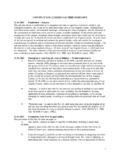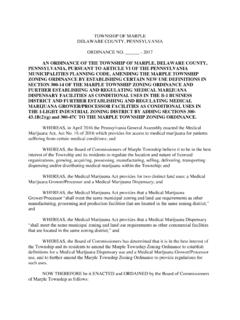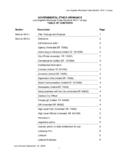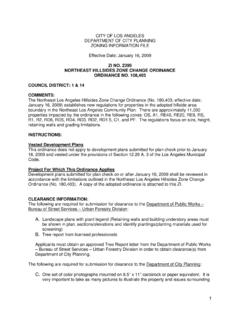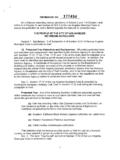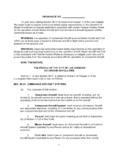Transcription of Chapter 21 LAND USE ORDINANCE Articles: 1. …
1 -1- Chapter 21 LAND USE ORDINANCE Articles: 1. general provisions 2. Administration and Enforcement 3. Establishment of Zoning Districts and Zoning District Regulations 4. general Development Standards 5. Specific Use Development Standards 6. Off-Street Parking and Loading 7. Sign Regulations 8. Optional Development Regulations 9. Special District Regulations 10. Definitions Appendices: A. (Reserved) B. Zoning Ordinances C. Zoning Maps D. Resolutions--Plan Review Use Approvals E. Interim Control Ordinances F. Kakaako Special Design District G. List of Figures H. Amendments to Planned Development, Conditional Use Permit, and Cluster Approvals I. Key to Department Abbreviations article 1. general provisions Sections: Title. Purpose and intent.
2 Administration. Appeals. Variances. Temporary uses. Sec. Title. The provisions of this Chapter , inclusive of any amendments, shall be known as the land use ORDINANCE (LUO) of the City and County of Honolulu. The provisions may also be referred to as the zoning ORDINANCE and may, to the extent practicable, contain other ordinances regulating the utilization of land pursuant to Section 6-1504 of the charter. (Added by Ord. 99-12) Sec. Purpose and intent. (a) The purpose of the LUO is to regulate land use in a manner that will encourage orderly development in accordance with adopted land use policies, including the Oahu general plan and development plans, and to promote and protect the public health, safety and welfare by, more particularly: (1) Minimizing adverse effects resulting from the inappropriate location, use or design of sites and structures; (2) Conserving the city's natural, historic and scenic resources and encouraging design which -2- enhances the physical form of the city; and (3) Assisting the public in identifying and understanding regulations affecting the development and use of land.
3 (b) It is the intention of the council that the provisions of the LUO provide reasonable development and design standards for the location, height, bulk and size of structures, yard areas, off-street parking facilities, and open spaces, and the use of structures and land for agriculture, industry, business, residences or other purposes. (Added by Ord. 99-12) Sec. Administration. The director shall administer the provisions of the LUO. (Added by Ord. 99-12) Sec. Appeals. Appeals from the actions of the director in the administration of the provisions of the LUO shall be to the zoning board of appeals as provided by Section 6-1516 of the charter. Appeals shall be filed within 30 days of the mailing or service of the director's decision. (Added by Ord. 99-12) Sec. Variances. Petitions for varying the application of the provisions of the LUO shall be determined pursuant to Sections 6-1516 and 6-1517 of the charter, including the application of the provisions relating to signs.
4 (Added by Ord. 99-12) Sec. Temporary uses. Uses and structures of a temporary nature shall not be governed by this Chapter , unless the director determines that significant impacts upon the surrounding area warrant review, and, when necessary, the imposition of conditions on the use or structure. Conditions shall be based on impacts upon the surrounding area, and may cover hours of operation, duration of the activity, and general manner of operation. (Added by Ord. 99-12) article 2. Administration and Enforcement Sections: Purpose. Administrative procedures. Application procedures. Permits. Minor permits. Major permits. Multipermit process. Rules governing director's failure to act within specified time period. Review of planning commission and/or council. Conditional zoning--Agreements.
5 Conditional use permit--Purpose and intent. Application requirements. general requirements. Existing uses. Exceptions. Cluster housing, agricultural and country clusters. Planned development-resort and planned development-commercial projects. Designation of ohana-eligible areas. Plan review uses--Purpose and intent. Applicability. -3- general provisions . Application requirements. Waiver of requirements. Zoning adjustments. Specific circumstances. Criteria. Violation. Criminal prosecution. Administrative enforcement. Figures: Permit Application--Processing Time. Zoning Adjustment: Grade Irregularities.
6 Sec. Purpose. The purpose of this article is to set forth the procedures for processing permit applications and to ensure compliance with all provisions of this Chapter . Concurrent application and processing are encouraged for projects that require multiple permits. (Added by Ord. 99-12) Sec. Administrative procedures. (a) No permit required by this Chapter shall be granted or application accepted for any use, structure or project on any zoning lot in conflict with a proposed zone change, including an amendment to or establishment of any special district, between the time the proposal is initiated by the director or the council and the time the proposal is withdrawn, or approved or denied by the council. This provision shall not apply for a period of more than one year from the date of initiation of the proposal. (b) If a permit required by this Chapter requires a public hearing, no request for postponement of the hearing shall be allowed after notice has been published; however, the applicant may withdraw the permit application.
7 (c) In the event a permit required by this Chapter is denied, or in the event the applicant withdraws the permit application, one year shall elapse before the permit application is resubmitted in the same or substantially the same form; provided that if the denial or withdrawal was the result of infrastructure inadequacies and these inadequacies are subsequently corrected, then the director may accept a new application prior to the lapse of the one-year period. (d) The director shall notify an applicant in writing whether an application for a permit required by this Chapter is complete or incomplete within 10 working days of its receipt by the director. When the application is incomplete the notice shall inform the applicant of the specific requirements necessary to complete the application. The application shall not be accepted by the director unless it is complete. (e) Applications previously approved by ORDINANCE shall continue to be regulated by the provisions of that ORDINANCE , except that: (1) The director may administratively modify cluster housing and planned development-housing projects that were originally approved by ORDINANCE ; (2) All such modifications shall be processed in accordance with current site design standards and application procedures.
8 (f) Applications previously approved, other than by an ORDINANCE , shall continue as approved; provided, that any reference to an approving body shall be construed as the approving body contained in the applicable regulation of this Chapter . (g) Nothing contained in this Chapter shall be deemed to prevent the strengthening or restoration to a safe condition of any building, or any part of any building, declared to be unsafe by any official charged with protecting the public safety, upon order of such official. (h) The department monitors compliance with and enforces the provisions of this Chapter only. Accordingly, the issuance of a permit pursuant to this Chapter does not constitute the department's confirmation that the applicant has complied with any other applicable laws. -4- (i) In addition to the requirements stated in this Chapter for the issuance of any permit, it shall be the responsibility of the applicant to observe and comply with all other applicable federal, state and city laws, ordinances, rules and regulations.
9 (j) All references in this Chapter to a government agency or department shall mean the government agency or department specifically identified or its successor. (Added by Ord. 99-12) Sec. Application procedures. (a) The application procedures specified in this section shall be followed in the administration of this Chapter . As used in this section, "applicant" includes but is not limited to any governmental agency or entity. (b) Application fees are not refundable and shall be required as specified in Chapter 6, article 41. (c) See Figure for permit application processing. (Added by Ord. 99-12) -5- -6- -7- -8- -9- -10- Sec. Permits. There shall be two categories of permits authorized by this Chapter : minor and major. The following sections describe the review and processing of applications for permits and approvals within these two categories. (Added by Ord. 99-12) Sec.
10 Minor permits. (a) Specific Permits. The minor permit category consists of the following permits and approvals: (1) Zoning adjustment; (2) Waiver; (3) Existing use permit; (4) Conditional use permit (minor); and (5) Special district permit (minor). (b) Preapplication Procedures. Before submitting an application for a minor permit, except an existing use permit, for the following uses: (1) Transmitting antenna mounted on a building or rooftop in a country, residential, A-1, or AMX-1 district, or a freestanding antenna structure; (2) Meeting facility; (3) Day-care facility; or (4) Schools: elementary, intermediate and high; the applicant shall first present the project to the neighborhood board of the district where the project will be located, or, if no such neighborhood board exists, an appropriate community association.

